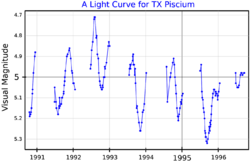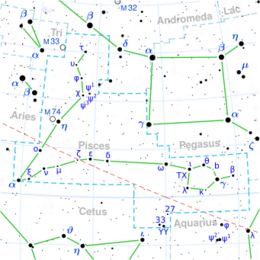Astronomy:TX Piscium
| Observation data Equinox J2000.0]] (ICRS) | |
|---|---|
| Constellation | Pisces |
| Right ascension | 23h 46m 23.51645s[1] |
| Declination | +03° 29′ 12.5190″[1] |
| Apparent magnitude (V) | 4.79 - 5.20[2] |
| Characteristics | |
| Spectral type | C7,2[3] |
| U−B color index | +3.33[4] |
| B−V color index | +2.60[4] |
| Variable type | Lb[2] |
| Astrometry | |
| Radial velocity (Rv) | +11.5±1.5[5] km/s |
| Proper motion (μ) | RA: −32.086[1] mas/yr Dec.: −24.545[1] mas/yr |
| Parallax (π) | 4.0894 ± 0.2124[1] mas |
| Distance | 800 ± 40 ly (240 ± 10 pc) |
| Absolute magnitude (MV) | −2.22[5] |
| Details | |
| Mass | 1 – 3[6] M☉ |
| Radius | 295[6] R☉ |
| Luminosity | 7,019 – 7,876[6] L☉ |
| Surface gravity (log g) | −0.2 – −0.5[6] cgs |
| Temperature | 3,080 – 3,170[6] K |
| Metallicity [Fe/H] | −0.39[7] dex |
| Other designations | |
| Database references | |
| SIMBAD | data |
TX Piscium (19 Piscium) is a variable red giant star in the constellation Pisces. It is amongst the reddest naked eye stars, with a significant reddish hue when seen in binoculars. It is approximately 800 light years from Earth.
Spectrum
TX Piscium is a very red star, 2.6 magnitudes fainter at blue wavelengths than in the middle of the visual range, and another 3.3 magnitudes fainter in the ultraviolet.[4]
It has been given a spectral class C7,2, indicating a relatively cool carbon star with only modest C2 band strength.[3] It has alternately been classified as C-N5 C24, suggesting a warmer star with stronger C2 bands.[8] Spectral features have been observed to vary.[9]
Variability

The apparent magnitude of TX Piscium varies between +4.9 and +5.5 and it is classified as a slow irregular variable.[2] Photometry has shown some periodicity in the brightness of 224 days, and some spectral variation over 450 days, suggesting the star is not entirely irregular.[9]
The star apparently lies on the period-luminosity relation corresponding to fundamental mode pulsations, unusual for a low-amplitude semi-regular or irregular variable which usually pulsate in an overtone.[11] The angular diameter has been measured at around 10 mas, although this varies depending on the observed wavelength and the atmosphere appears to be highly asymmetric. There may be one or more "blobs" of ejected material near the star.[11][9] Some observations show the angular diameter to change in synchrony with the visual brightness.[11]
Properties
TX Piscium is a thermally-pulsing asymptotic giant branch (TP-AGB) red giant star, which means that it is alternately fusing helium in a shell around its core and fusing hydrogen in a shell closer to its surface. Stars on the TP-AGB are generally unstable, with high mass loss and pulsations.
The periodic flashes of the helium shell in a red giant star are known as thermal pulses and cause the hydrogen shell to be extinguished. This creates strong convection and the third dredge-up (TDU) which brings helium fusion products such as carbon to the surface. After several TDUs, the abundance of carbon in the atmosphere begins to exceed that of oxygen and then the star is known as a carbon star. In TX Piscium, the carbon/oxygen ratio is calculated to be 1.03, which is at the low end of the scale of carbon stars.[7] It is thought to be a relatively new carbon-rich red giant star.[9]
TX Piscium has a mass of approximately 2 M☉. Modelling of its observed properties suggest a mass between 1 and 2 M☉, while evolutionary models suggest a mass between 2 and 3 M☉. In particular, stars with a mass below 2 M☉ are not expected to become carbon stars.[6]
The temperature of TX Piscium is thought to vary between 3,080 K at minimum visual brightness and 3,170 K at visual maximum. Similarly, its luminosity varies between 7,019 and 7,876 L☉. Many of its physical properties are uncertain due to uncertainty in its distance. The Hipparcos parallax corresponds to a distance of 275 parsecs, but other estimates give distances as high as 315 parsecs.[6]
References
- ↑ 1.0 1.1 1.2 1.3 1.4 Vallenari, A. et al. (2022). "Gaia Data Release 3. Summary of the content and survey properties". Astronomy & Astrophysics. doi:10.1051/0004-6361/202243940 Gaia DR3 record for this source at VizieR.
- ↑ 2.0 2.1 2.2 Samus, N. N. et al. (2009). "VizieR Online Data Catalog: General Catalogue of Variable Stars (Samus+ 2007-2013)". VizieR On-line Data Catalog: B/GCVS. Originally Published in: 2009yCat....102025S 1. Bibcode: 2009yCat....102025S.
- ↑ 3.0 3.1 Yamashita, Yasumasa (1972), "The C-classification of the spectra of carbon stars", Annals of the Tokyo Astronomical Observatory 13 (3): 167, Bibcode: 1972AnTok..13..169Y
- ↑ 4.0 4.1 4.2 Ducati, J. R (2002). "VizieR Online Data Catalog: Catalogue of Stellar Photometry in Johnson's 11-color system". CDS/ADC Collection of Electronic Catalogues 2237. Bibcode: 2002yCat.2237....0D.
- ↑ 5.0 5.1 Anderson, E.; Francis, Ch. (2012), "XHIP: An extended hipparcos compilation", Astronomy Letters 38 (5): 331, doi:10.1134/S1063773712050015, Bibcode: 2012AstL...38..331A.
- ↑ 6.0 6.1 6.2 6.3 6.4 6.5 6.6 Klotz, D; Paladini, C; Hron, J; Aringer, B; Sacuto, S; Marigo, P; Verhoelst, T (2013). "Catching the fish – Constraining stellar parameters for TX Piscium using spectro-interferometric observations". Astronomy & Astrophysics 550: A86. doi:10.1051/0004-6361/201220444. Bibcode: 2013A&A...550A..86K.
- ↑ 7.0 7.1 Abia, C; Cunha, K; Cristallo, S; De Laverny, P (2015). "The origin of fluorine: Abundances in AGB carbon stars revisited". Astronomy & Astrophysics 581: A88. doi:10.1051/0004-6361/201526586. Bibcode: 2015A&A...581A..88A.
- ↑ Barnbaum, Cecilia; Stone, Remington P. S; Keenan, Philip C (1996). "A Moderate-Resolution Spectral Atlas of Carbon Stars: R, J, N, CH, and Barium Stars". The Astrophysical Journal Supplement Series 105: 419. doi:10.1086/192323. Bibcode: 1996ApJS..105..419B.
- ↑ 9.0 9.1 9.2 9.3 Hron, J; Uttenthaler, S; Aringer, B; Klotz, D; Lebzelter, T; Paladini, C; Wiedemann, G (2015). "The complex environment of the bright carbon star TX Piscium as probed by spectro-astrometry". Astronomy & Astrophysics 584: A27. doi:10.1051/0004-6361/201526862. Bibcode: 2015A&A...584A..27H.
- ↑ Wasatonic, Richard P. (January 1997). "Photoelectric Photometry of TX Psc, Alpha Her A, Omicron Cet, and RT Cyg". The Journal of the American Association of Variable Star Observers 26 (1): 1–13. Bibcode: 1997JAVSO..26....1W. https://ui.adsabs.harvard.edu/abs/1997JAVSO..26....1W. Retrieved 23 February 2022.
- ↑ 11.0 11.1 11.2 Cruzalèbes, P; Jorissen, A; Rabbia, Y; Sacuto, S; Chiavassa, A; Pasquato, E; Plez, B; Eriksson, K et al. (2013). "Fundamental parameters of 16 late-type stars derived from their angular diameter measured with VLTI/AMBER★". Monthly Notices of the Royal Astronomical Society 434 (1): 437–450. doi:10.1093/mnras/stt1037. Bibcode: 2013MNRAS.434..437C.
 |


